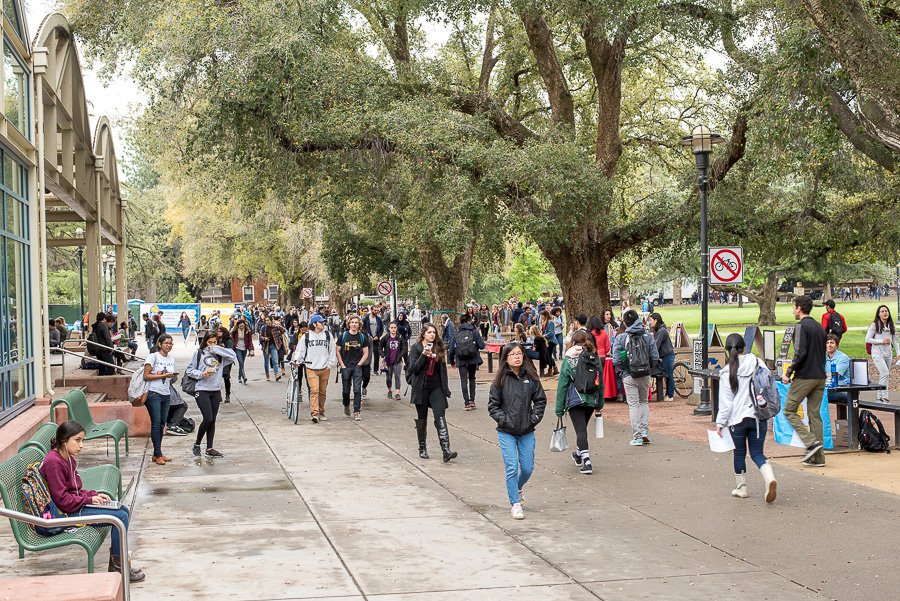
A look into the tabling culture at UC Davis
The Quad is always full of students passing through on their way to class and hanging out on the lawn eating lunch. Other students, however, are out tabling to promote student clubs and organizations.
On the first Friday of Spring Quarter, what would normally be a bustling day at the Memorial Union (MU) was quieted by a heavy downpour of rain — but this did not stop students like John Sung, a third-year chemical engineering major, who was promoting Koinonia Christian Fellowship and publicizing an event later that evening. According to Sung, tabling is an effective way to connect personally with other students.
“We get people to think about what we are about,” Sung said. “And we get to learn about other people too, it’s nice.”
Through rain or shine, members of Koinonia tabled throughout the first week of the quarter. Although sitting at a table and talking about an organization may seem simple, there is a lot more planning that goes into tabling.
“You’re supposed to reserve the tables four weeks in advance,” Escareno said. “And [when we tried to], they were all taken. If you want to get on the waitlist you have to go upstairs of the MU and try to […] get on the waitlist.”
For those who do not sign up for a table right away, there is still hope that an organization that did sign up might not show up to claim its table. According to Escanero, the waitlist can be long, and it may be difficult to get a table that way.
“Usually in the first two weeks it’s […] really packed,” Escanero said. “But then after that, it’s relatively easier to get a table.”
The Quad is a bustling area, full of students heading off to the next activity on their to-do list. It seems like the perfect location for an organization to publicize, but many students do not want to stop and listen.
“I’ve had people with headphones [pass by],” said Jasmine Osmany, a third-year environmental policy major. “You know that they hear you and they just walk the opposite direction.”
Even with this obstacle, students like Alena Dinh, a second-year neurobiology, physiology, and behavior major, have picked up some tricks to get the attention of students passing through.
“First thing is a smile,” Dinh said. “If you approach [students] very seriously then it’s going to be intimidating. Some ways I’ve heard it done is like ‘are you interested in a pre-health internship?’ or some people go more outrageous just to catch attention. If you can keep them for the first three seconds then you have a conversation.”
Even when executed well, these strategies for tabling do not work perfectly every time. According to Dinh, some students are more difficult to reach.
“[Students] just walk away [from the tables],” Dinh said. “I mean, I’ve been on that side too, so I know what it’s like.”
The tabling process is different for organizations that are not directly a part of UC Davis. For example, Marble Mosaic is a social media application created by UC Davis students for UC Davis students, but it is independent of the university itself. Outside organizations like Marble can table at the MU, but there are more requirements in order to get approved, according to Ted Mumford, a recent UC Davis graduate and a founder of the app “Marble.”
“As an outside organization you can’t necessarily just show up and table,” Mumford said. “But […for outside groups, ASUCD] can say, ‘okay, we’ll reserve the table for you’.”
The tables are lined up along the walkway that cuts through the MU and the Quad. This area is a central location on campus that Mumford found to be a perfect area to reach many different students. When at the MU, his organization took a different angle at first — something they call “backward tabling,” that is, approaching students instead of waiting to be approached.
“Today is our first day of tabling,” Mumford said. “[Before today,] we’ve been doing backwards tabling, which we find to be great because we are trying to reach groups who are looking to reach other students.”
According to Dinh, printing handouts with information is another effective way for students to publicize their organizations.
“You’re publicizing your [group],” Dinh said. “It’s kind of like, ‘please take this [flyer]’ and take the time to listen to us. You’re trying to sell yourself and your cause.”
Like Dinh, Escanero handed out flyers while tabling as well. She found that people were more willing to take a handout rather than stopping to talk.
“Rarely someone comes up to us,” Escanero said. “I feel like people are usually shy to come up and talk or we will just go up to them and hand them a flyer. ”
Unlike Escanero and Dinh, Mumford did not create flyers for his group, which led to difficulties during his first week of tabling.
“We are trying to do this without any flyers, which is a little bit tricky,” Mumford said. “Everyone is just like ‘oh let me take something’ and […] we don’t want to waste paper.”
While there are difficult aspects of tabling that make it seem like it may not be the most effective way to reach a large quantity of students, some groups find that it is actually useful. According to Dinh, even if it only reaches a small number of students, it may just be the students they need.
“I think for the vast majority of people, [they] pass us by,” Dinh said. “There are people who are interested and do come in and that’s actually how I heard about our clinic so it was successful for me. I still think [tabling] is useful.”
Written by: Elizabeth Marin — features@theaggie.org




Great article, thanks!